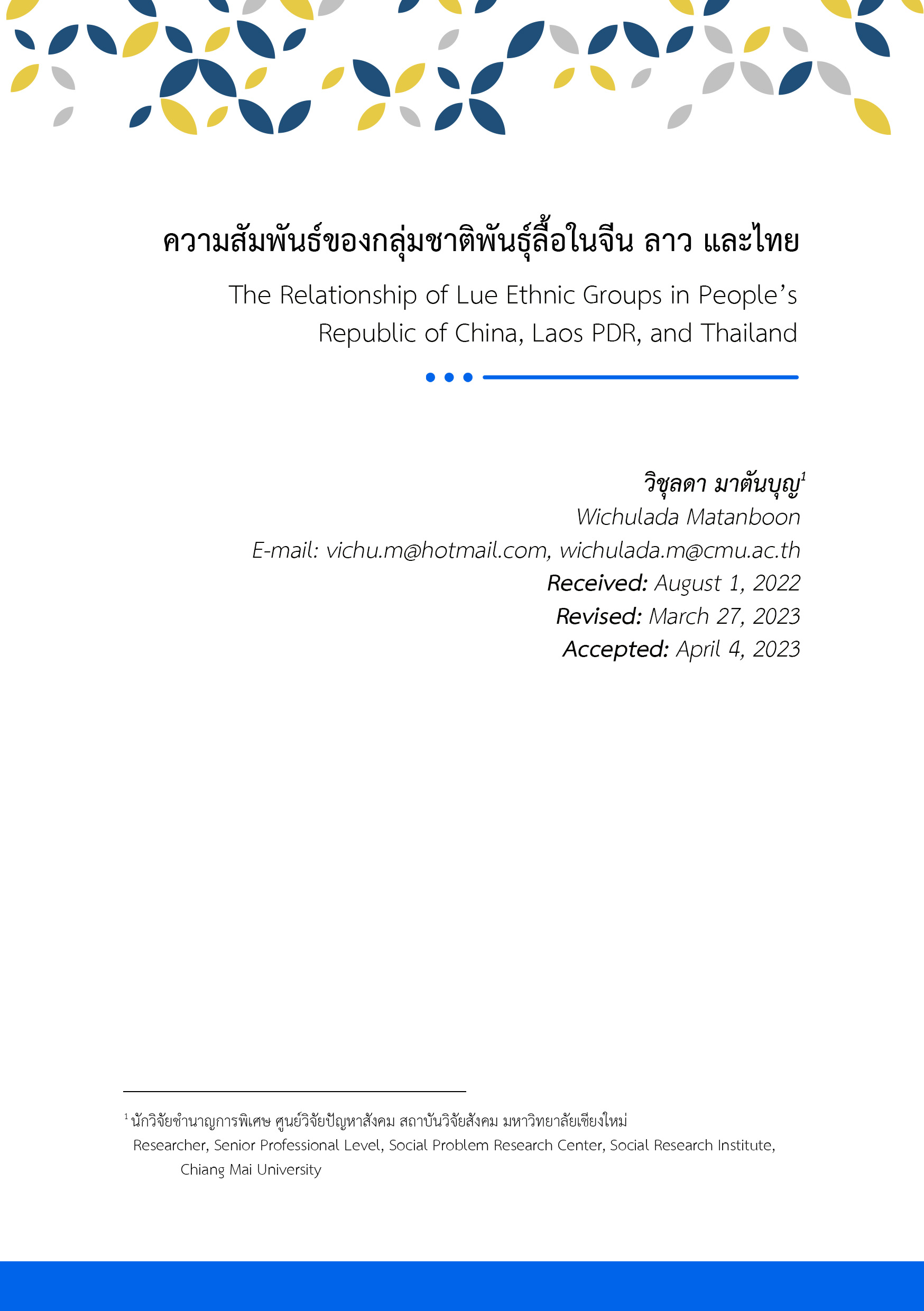The Relationship of Lue Ethnic Groups in People’s Republic of China, Laos PDR, and Thailand ความสัมพันธ์ของกลุ่มชาติพันธุ์ลื้อในจีน ลาว และไทย
Main Article Content
Abstract
The relationship of Lue ethnic groups in People's Republic of China, Laos PDR, and Thailand is a qualitative research study. The aim of this research is to study the relationship of Lue ethnic groups in China, Laos and Thailand. The research areas cover a Chiang Khong District, Chiang Rai Province, the Lue Community in Bo Kaeo Sub-District in Lao People's Democratic Republic and the Lue community in Xishuangbanna Dai Autonomous Prefecture, Yunnan Province, in People's Republic of China. This research uses observational data collection methods, in-depth interviews, group discussions, community conferences and the organization of academic conferences to analyses the dataset. The research found that Lue people in all three countries are linked together based on 1) The Lue ethnicity, including kinship and bloodline, trading network, traditions and culture, history and origin of Lue people in each area; 2) Buddhism and ancestral beliefs, including household spirits and city spirits that they respect and serve as a heart of Lue community; 3) Some areas established relationships through formal networks and participation in government activities; and 4) Trading networks and business. The relationships between the Lue ethnic group in Thailand and the Lue ethnic group in China, and the Lue ethic group in Thailand and the Lue ethnic group in Lao PDR were mostly similar. The Lue ethnic group in Thailand and the Lue ethnic group in China, however, established a new form of cross-border relationship through Lue Thailand Association with Lue Xishuangbanna Yunnan, People’s Republic of China, and the Chinese student network in Thailand. The Lue ethnic group in Thailand and the Lue ethnic group in Lao PDR established a relationship through participation in government activities. Nowadays, an important factor that helps Lue people to strengthen relations even in different countries is the policies for social and economic development of the state with the construction of the 4th Thai-Lao Friendship Bridge. Also, the Internet network facilitates faster and easier communication.
Downloads
Article Details

This work is licensed under a Creative Commons Attribution-NonCommercial-NoDerivatives 4.0 International License.
References
Axhausen, K.W., Frei, A. (2008). Contacts in a Shrunken World. In: Paper presentedat the 86th Annual Meeting of the Transportation Research Board, Washington, D.C.
Baba, Yuji (2014). Relatedness and Belonging: The Tai Lue Community in Nan. University of Sydney, Australia.
Changphuak, S. (2003). Lue at Phanom: the cultural relations in touristic space, Luang Prabang province, Lao. Master of Arts thesis. Social Sciences. Chaingmai University, Chiang Mai.
Clifford, J. (1994). Diasporas. Cultural Anthropoly. 9(3), 302–338.
Dahinden, J. (2010). The dynamics of migrants’ transnational formations: betweenmobility and locality. In: Baubock, R., Faist, T. (Eds.), Diaspora andTransnationalism: Concepts, Theories and Methods. Amsterdam UniversityPress, Amsterdam, pp. 51–72.
Geo - Informatics and Space Technology Development Agency. (2022). Mekong River. Retrieved 10 February 2022, from https://www.gistda.or.th/ news_view.php?n_id=6513&lang=TH.
Granovetter, M.S. (1973). The strength of weak ties. American Journal of Community Psychology 78, pp. 1360–1380.
Keyes, C. (1993). Who Are The Lue? Revisited Ethnicity in Laos, Thailand, and China. WA: University of Washington.
Larsen, J., Urry, J. and Axhausen, K.W. (2006). Mobilities, Networks, Geographies. Ashgate, Aldershot.
Leepreecha, P. (2015). Economy Identity Opium Hmong Chiang Mai. Research Report. Khon Kaen University.
Licoppe, C. (2004). ‘Connected’ presence: the emergence of a new repertoire formanaging social relationships in a changing communication technoscape.Environ. Plan. Soc. Space 22 (1), pp. 135–156.
Matanboon, W. (2018). The Conservation, Continue and Staying of Weave Wisdom Reflection of Tai–Lu Wisdom Adaptation in Chiang Khong District, Chiang Rai Province. Journal of Cultural Approach. 19(35), 89-96.
Matanboon, W. (2019). Ethnic records of the Sridonchai community Chiang Khong District Chiang Rai. Lan Na Thi ethnic learning center, Social Research Institute, Chiang Mai University. Nuntapun Printing.
Matanboon, W. (2019). Food Unseen Tai Lue Volume 1. Chiang Mai: Lan Na Thi ethnic learning center, Social Research Institute, Chiang Mai University.
Matanboon, W. (2019). Food Unseen Tai Lue Volume 2. Chiang Mai: Lan Na Thi ethnic learning center, Social Research Institute, Chiang Mai University.
Matanboon, W. (2019). Weaves, fabric patterns, Tai Lue wisdom, Volume 1. Chiang Mai: Lan Na Thi ethnic learning center, Social Research Institute, Chiang Mai University.
Matanboon, W. et al. (2013). Ethnography of the Thai plains in Lanna. Chiang Mai: Social Research Institute, Chiang Mai University.
Prangwattanakun, S. (1993). Lanna to Lan Xang. Bangkok: Aroonkarnpim Limitted Partnership.
Premchit, S. and Panyakaew, W. (2015). Legend of Lue local history, Dan Din, Chiang Rung Muang Yong, Muang Sing. Chiang Mai: wanida karnpim.
Ritphen, S. (2007). Visit Yung Thong Land, Xishuangbanna, Kingdom of Mekong ... Land of arts and culture Tai Lue way of life. Chaingmai: Nopburee press.
Simon Cristian Powedder. (2018). Exploring the Transnational World of Lao Small Scale Readers in the Yunnan, Laos, Thailand Borderland. Thesis, Department of Southeast Asia Studies. National University of Singapore.
Suwansathit, S. (1992). Tracing Tai Lue Textiles from Lanna to Xishuangbanna: Introduction and Observations on Faith in Buddhism and the Succession of Thai Lue Textiles at Xishuangbanna. Office of the National Cultural Commission.
Thippimol, O., Saigampa, T., Preecharushh, D., Ganjanakhumdee, S. and Khamkhum, A. (2011). Boundaries of Siam/Thailand-Malaysia-Burma-Laos-Cambodia. Bangkok: The Foundation for The Promotion of Social Science and Humanities Textbooks Project.
Urry, J. (2003).Social Networks, travel and talk. British Journal of Sociology 54 (2),155–175, http://dx.doi.org/10.1080/0007131032000080186.
Vadhanaphuti, C., Leepreecha, P. and Suknaphasawat, J. (1991). Ethnic Studies in Laos and Thailand. Report on the seminaron. Chiang Mai.
Viry, G. (2012). Residential mobility and the spatial dispersion of personalnetworks: effects on social support. Soc. Netw. 34 (1), 59–72.
Wongthes, S. (1994). The thais were always here in Southeast Asia. Bangkok: Silpawattanatham.


